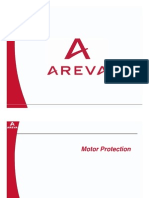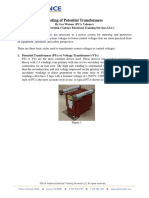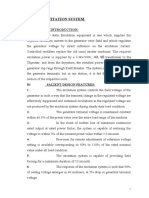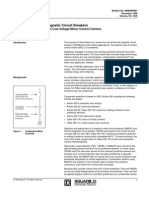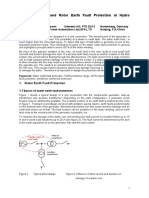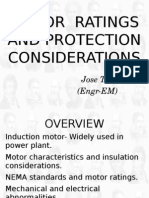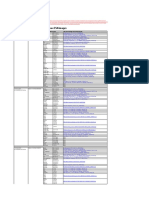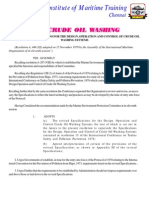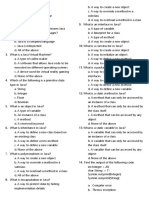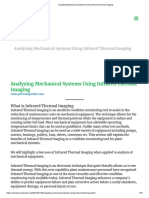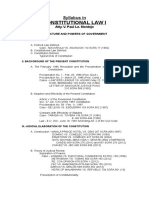g
GE Power Management
Motor Management Relay Course
GE Power Management
GE Power Management
GE Power Management
GE Power Management
Motor Theory
GE Power Management
Motor Theory
A2
A1
GE Power Management
Motor Theory
Two main components comprise a 3 phase AC induction motor: Rotor Stator
A Slight air gap exists between the rotor and stator
GE Power Management
Motor Theory
GE Power Management
Motor Theory
Ns = 120 F P
Pole # 2 4 6 8 10 Synchronous 3600 1800 1200 900 720
GE Power Management
Motor Theory
GE Power Management
Motor Theory
GE Power Management
Motor Theory
GE Power Management
Motor Theory
% Slip = Ns - Nr x 100 % Ns
GE Power Management
Motor Specifications
600%
Starting Current: when rated voltage and frequency is applied to NEMA B motor, it will typically draw 600% of full-load current and decrease to rated value as rotor comes up to speed
100%
GE Power Management
Motor Specifications
Torque Radius
Force
Torque
= Force x Radius = Force x Radius x 2 / Time
Distance = Circumference = Radius x 2 Power
GE Power Management
Motor Specifications
Horsepower: Engineering unit of power
33,000 lb 1ft in 1 min
GE Power Management
Motor Specifications
Efficiency: an indication of how much electrical energy is converted to output shaft mechanical energy expressed as a percentage. Losses Core loss Stator loss Rotor Loss Electrical Energy in Mechanical Energy Friction and Windage Stray loss
Electrical Energy in = Mechanical Energy out + Losses (mostly heat)
GE Power Management
Motor Specifications
Classes of Insulation:
Class A Class B Class F Class H
GE Power Management
Motor Specifications
Service Factor: When the voltage and frequency are maintained at the values specified on the nameplate the motor may be overloaded up to the horsepower obtained by multiplying the nameplate horsepower by the service factor. At the service factor load greater then 1.0 the motors efficiency, power factor and speed will differ from nameplate. But the locked rotor current and breakdown torque will remain the same. For a given insulation motors with a 1.15 service factor have a lower rise then those with a service factor of 1.0. This allows the motor to operate close to the service factor without exceeding rated temperature limits of the insulation. If the motor is operated at the Service factor the motor will have a temperature rise in excess of the 100% rated rise for motors with a 1.0 service factor. This will shorten the life expectancy considerably.
GE Power Management
Review: Basic Low voltage motor protection
GE Power Management
Information required:
Motor FLA Locked Rotor Current Locked Rotor Time Hot Locked Rotor Time Cold Safe Stall Time Cold Service Factor Motor damage curve
GE Power Management
The Motor Management Relays have three basic categories of protection elements:
TRIPS ALARMS BLOCKS
GE Power Management
Trips
GE Power Management
Alarms
GE Power Management
Block Starts
GE Power Management
Thermal Modeling
Thermal Modeling:
Select O/L Curve Determine Overload Pickup Hot/Cold safe stall ratio Unbalanced Bias Cooling Times and start inhibit RTD biasing
GE Power Management
Thermal Modeling Starting Current Ambient Temperature
Motor Losses
Unbalanced Current
Overload setpoint Volume depending on motor Motor Cooling
GE Power Management
Thermal Modeling
40%
Thermal Capacity required to start
80%
Thermal Capacity Used due to Overload
20%
80%
60%
Thermal Capacity must decay by 20% (from 80% to 60% Used) in order to start the motor
Figure 2-1
GE Power Management
Thermal Modeling
Thermal Modeling:
Select O/L Curve Determine Overload Pickup Hot/Cold safe stall ratio Unbalanced Bias Cooling Times and start inhibit RTD biasing
GE Power Management
Thermal Modeling
Typical Motor Thermal limits Curve
Thermal limit curve when motor is cold
Time in seconds
Thermal limit curve when motor is hot Acceleration curve @ 80% rated voltage Acceleration curve @100% voltage
Phase current in multiplies of FLC
GE Power Management
Thermal Modeling
Built in overload curves
GE Power Management
Thermal Limit Curves
100000
Thermal Modeling
Motor Manufacturer's Thermal Limit Curve
269 Plus Custom Overload Curve 10000
1000 44 sec. Time (seconds)
Therefore, after this motor has completed a successful start, the Thermal Capacity would have reached approximately 40%.
Motor Acceleration Curve 38 sec. 100
9 sec. 10 3 sec
1 101 140 180 220 260 300 340 380 420 460 500 540 580 Percent Full Load 620 20 60
Figure 8.3
GE Power Management
Thermal Limit Curves
100000
Thermal Modeling
Motor Manufacturer's Thermal Limit Curve
269 Plus Custom Overload Curve 10000
Therefore, after this motor has completed a successful start, the Thermal Capacity would have reached approximately 40%.
44 sec.
1000 Time (seconds)
Motor Acceleration Curve 38 sec. 100
9 sec. 10 3 sec
Figure 8.3
1 101 140 180 220 260 300 340 380 420 460 500 540 580 Percent Full Load 620 20 60
GE Power Management
Thermal Modeling
If a 40% TC was used to start initially running O/L curve area will be reduced by 40% from that of the cold curve area
GE Power Management
Thermal Modeling
Thermal Modeling:
Select O/L Curve Determine Overload Pickup Hot/Cold safe stall ratio Unbalanced Bias Cooling Times and start inhibit RTD biasing
GE Power Management
Thermal Modeling
Thermal Modeling:
Select O/L Curve Determine Overload Pickup Hot/Cold safe stall ratio Unbalanced Bias Cooling Times and start inhibit RTD biasing
GE Power Management
Thermal Modeling
Time in seconds
b d 15 c 10 1 a Phase Current in Multiplies of FLC
GE Power Management
Thermal Modeling
Thermal Modeling:
Select O/L Curve Determine Overload Pickup Hot/Cold safe stall ratio Unbalanced Bias Cooling Times and start inhibit RTD biasing
GE Power Management
Thermal Modeling
GE Power Management
Thermal Modeling
GE Power Management
Thermal Modeling
GE Power Management
Thermal Modeling
Thermal Modeling:
Select O/L Curve Determine Overload Pickup Hot/Cold safe stall ratio Unbalanced Bias Cooling Times and start inhibit RTD biasing
GE Power Management
Thermal Modeling
Thermal Model Cooling 80% load
Thermal Model Cooling 100% load
GE Power Management
Thermal Modeling
Thermal Model Cooling Motor Stopped
Thermal Model Cooling Motor Tripped
GE Power Management
Thermal Modeling
Thermal Modeling:
Select O/L Curve Determine Overload Pickup Hot/Cold safe stall ratio Unbalanced Bias Cooling Times and start inhibit RTD biasing
GE Power Management
Thermal Modeling
RTD input is a indicator of the thermal capacity used dependent on stator temperature (very slow). The relay will use the calculated thermal capacity unless the RTD thermal capacity is higher.
Figure 8.4: RTD Bias Curve Example
GE Power Management
Instantaneous Short Circuit Protection
100000
10000
Instantaneous Overcurrent Protection
Motor Thermal Limit
1000 Time (seconds) 100
Acceleration curve (motor current during starting)
10
Locked Rotor current
1 101 140 180 220 260 300 340 380 420 460 500 540 580 Percent Full Load 605 20 60
GE Power Management
Ground Fault
Resistive Grounded System and a Inductive Grounded System
GE Power Management
Ground Fault
Figure 4.2: Zero Sequence CT (Moisey, 1997)
GE Power Management
Ground Fault
Figure 4.3: Residual Ground Fault Connection (Moisey, 1997)
GE Power Management
DC Offset
Ground Fault
Figure 4.4: Asymmetrical Starting Current (GE Multilin, 1998)
GE Power Management
Phase Differential
GE Power Management
Mechanical Jam
GE Power Management
Undercurrent
GE Power Management
Under Voltage
If an induction motor operating at full load is subjected to an under voltage condition, the following effects will occur (Moisey, 1997): Full load speed will decrease efficiency will decrease power factor will increase full load current will increase temperature will increase Most motors are designed close to the saturation point: increasing the V/HZ ratio could cause saturation of air gap flux causing heating
GE Power Management
Overvoltage
When the motor is running in an overvoltage condition, the following affects will occur (Moisey, 1997): slip will decrease because slip is inversely proportional to the square of the voltage efficiency will increase slightly and power factor will decrease because the current being drawn by the motor will decrease temperature rise will decrease because the current has decreased (based on the formula I2t)
GE Power Management
Acceleration Timer
GE Power Management
GE Power Management
Soft Starter Using Autotransformer
GE Power Management .03 ohm
C.T. Characteristics
.02 ohm
.01 ohm
Secondary Voltage
Vk Knee Point: The point at which a 10% increase in voltage produces a 50% increase in magnetizing current Vf
Exciting current
GE Power Management
GE Power Management
GE Power Management
GE Power Management
AC Saturation
No Saturation
Partly Saturated
Sever Saturation
GE Power Management
DC Saturation
Primary current Secondary Current
GE Power Management
GE Power Management
GE Power Management
GE Power Management
24 15
GE Power Management
GE Power Management
GE Power Management
ANSI Device Numbers
2 21 25 27 30 32 37 38 40 46 47 49 50 51 59 60
Time-delay Distance Synchronism-check Undervoltage Annunciator Directional power Undercurrent or under power Bearing Field Reverse-phase Phase-sequence voltage Thermal Instantaneous Overcurrent AC time overcurrent Overvoltage Voltage balance
63 64 67 68 69 74 76 78 79 81 85 86 87 94
Pressure Apparatus ground AC directional OC Blocking Permissive Alarm DC overcurrent Out-of-step AC reclosing Frequency Carrier or pilotwire Lock out Differential Tripping
GE Power Management
GE Power Management
GE Power Management
GE Power Management
GE Power Management
239 Motor Protection Relay
FEATURES Status/current/temperature display Fault diagnosis Trip record Memory lockout Thermal capacity/load %/RTD analog output Trip/alarm/auxiliary/service relay outputs Simulation mode for field testing RS485 Modbus communications interface AC/DC control power Compact size, fits most starters Update options and/or MODs in field CSA/UL Approved
PROTECTION Overload (15 Selectable Curves) Short circuit Locked rotor Stall / mechanical jam Repeated starts Single phase/unbalance Ground fault Over temperature (Thermistor & 3 RTDs) Undercurrent Overload warning Breaker failure
GE Power Management
239 Motor Protection Relay
GE Power Management
GE Power Management
239 Motor Protection Relay
GE Power Management
269 Motor Protection Relay
GE Power Management
269 Motor Protection Relay
Control Latched main trip relay, alarm relay 2 auxiliary relays Emergency restart capability Pre-trip alarm warnings Optional single-shot restart Metering and Monitoring Motor current (Amps, % full load) Motor thermal capacity Record of pre-trip motor values Record of motor statistical data Up to 6 stator RTD inputs Four additional RTD inputs Motor ambient air temperature Continual self-test Ground fault current Optional MPM metering of V W vars PF Hz MWh
Application Three phase AC motors Mechanical system protection Protection Stator winding over temperature Bearing over temperature Multiple starts Overloads 8 standard overload curves User defined overload FlexCurve Locked rotor Rapid trip/mechanical jam Unbalance/single phasing Short circuit Ground fault Undercurrent Phase reversal (meter option) Variable lock-out time "Learns" individual motor parameters
�g
9
GE Power Management
269 Motor Protection Relay
GE Power Management
269 Motor Protection Relay
GE Power Management
369 Motor Protection Relay
GE Power Management
369 Motor Protection Relay
GE Power Management
GE Power Management
369 Motor Protection Relay
SR469 Motor Management Relay
GE Power Management
469 Motor Protection Relay
GE Power Management
GE Power Management
GE Power Management Ordering data
GE Power Management
SPM
GE Power Management
Applications Collector-ring synchronous motors Brushless type synchronous motors Control Field application PF regulation maximizes efficiency Reluctance torque synchronizing Re-synchronizing Auto loading/unloading
GE Power Management
SPM
GE Power Management
SPM
GE Power Management
GE Power Management
239 Motor Protection Relay
GE Power Management
239 Motor Protection Relay
GE Power Management
239 Motor Protection Relay Specifications
GE Power Management
Installation
GE Power Management
Installation
GE Power Management
#1
GE Power Management
Installation
GE Power Management
#3 No ground fault detection!
#2 Reduced ground fault speed of detection.
GE Power Management
GE Power Management
GE Power Management
GE Power Management
GE Power Management
GE Power Management
GE Power Management
GE Power Management
GE Power Management
GE Power Management
GE Power Management
GE Power Management
GE Power Management
GE Power Management
GE Power Management
GE Power Management
GE Power Management
Information required: Motor FLA Locked Rotor Current Locked Rotor Time Hot Locked Rotor Time Cold Safe Stall Time Cold Service Factor Motor damage curve
GE Power Management
GE Power Management
GE Power Management
GE Power Management
GE Power Management
GE Power Management
GE Power Management
GE Power Management
GE Power Management
GE Power Management
GE Power Management
Communications: Computer
GE Power Management
Setpoint: 239 Setup
GE Power Management
Setpoint: 239 Setup
GE Power Management
Setpoint: 239 Setup
GE Power Management
Setpoint: 239 Setup
GE Power Management
Setpoint: System Setup
GE Power Management
Setpoint: System Setup
GE Power Management
Start Time Allowed = SAFE STALL TIME COLDx((LOCKED ROTOR CURRENT)2 /(Actual Start Current) 2 ) Example: - normal inrush current is 6 x FLC - actual current inrush current was only 5 x FLC on a start - SAFE STALL TIME COLD has been set to 20 seconds maximum start time allowed would be: Start Time Allowed = SAFE STALL TIME COLDx((LOCKED ROTOR CURRENT)2 /(Actual Start Current) 2 ) = 20 x ((6) 2 /(5) 2 ) = 28.8 seconds
GE Power Management
GE Power Management
Setpoint: Protection
GE Power Management
GE Power Management
GE Power Management
GE Power Management
GE Power Management
GE Power Management
GE Power Management
GE Power Management
GE Power Management
GE Power Management
GE Power Management
GE Power Management
Lab 1
GE Power Management
GE Power Management
GE Power Management
GE Power Management
GE Power Management
GE Power Management
GE Power Management
GE Power Management
GE Power Management
GE Power Management
GE Power Management
GE Power Management
GE Power Management
Lab 2
GE Power Management
Setpoint: 239 Setup
GE Power Management
269 Motor Protection Relay
GE Power Management
GE Power Management
GE Power Management
Specifications
GE Power Management
GE Power Management
GE Power Management
GE Power Management
269 Installation
GE Power Management
269 Installation
GE Power Management
GE Power Management
GE Power Management
GE Power Management
GE Power Management
GE Power Management
GE Power Management
GE Power Management
GE Power Management
GE Power Management
GE Power Management
GE Power Management
GE Power Management
GE Power Management
GE Power Management
GE Power Management
GE Power Management
GE Power Management
GE Power Management
GE Power Management
GE Power Management
GE Power Management
GE Power Management
GE Power Management
GE Power Management
GE Power Management
GE Power Management
GE Power Management
GE Power Management
GE Power Management
GE Power Management
GE Power Management
369 Motor Protection Relay
GE Power Management
369 Motor Protection Relay
GE Power Management
369 Motor Protection Relay
GE Power Management
Specifications
GE Power Management
369 Installation
GE Power Management
GE Power Management
GE Power Management
GE Power Management
Figure 34: TYPICAL WIRING
GE Power Management
GE Power Management
Figure 36: ZERO SEQUENCE CT
GE Power Management
Figure 37: WYE/DELTA CONNECTION
GE Power Management
Figure 38: BACKSPIN VOLTAGE WIRING.
GE Power Management
RTD Wiring
GE Power Management
Digital Wiring
GE Power Management
Analog Output Wiring
GE Power Management
Relay Output Wiring
GE Power Management
GE Power Management
REMOTE RTD MODULE INSTALLATION
GE Power Management
Remote RTD Module
GE Power Management
Interface options
GE Power Management
GE Power Management
GE Power Management
GE Power Management
GE Power Management
GE Power Management
GE Power Management
GE Power Management
GE Power Management
GE Power Management
Software Installation
GE Power Management
GE Power Management
GE Power Management
GE Power Management
369 Configuration
GE Power Management
GE Power Management
Security
GE Power Management
GE Power Management
GE Power Management
GE Power Management
GE Power Management
GE Power Management
GE Power Management
GE Power Management
GE Power Management
GE Power Management
GE Power Management
GE Power Management
GE Power Management
GE Power Management
GE Power Management
GE Power Management
GE Power Management
GE Power Management
GE Power Management
Figure 4-9
GE Power Management
GE Power Management
GE Power Management
GE Power Management
GE Power Management
GE Power Management
GE Power Management
GE Power Management
GE Power Management
GE Power Management
GE Power Management
GE Power Management
GE Power Management
GE Power Management
GE Power Management
GE Power Management
GE Power Management
Digital Inputs
SR469 Motor Management Relay
GE Power Management
User Interface
GE Power Management
DISPLAY
40 character display Clear messages which do not require deciphering
STATUS INDICATORS
SR469 status Motor status Output relays
KEYS FOR LOCAL CONTROL Reset Next (to scroll messages) PROGRAM PORT INTERFACE RS232 for connection to a computer, 9600 baud
Numeric keypad HELP KEY
Provides context sensitive messages Control and programming keys for complete access without a computer
DRAWOUT HANDLE
with provision for a wire lead seal to prevent unauthorized removal
MAIN
GE Power Management
Specifications
GE Power Management
SR469 Installation
GE Power Management
GE Power Management
GE Power Management
GE Power Management
GE Power Management
GE Power Management
GE Power Management
GE Power Management
GE Power Management
GE Power Management
GE Power Management
GE Power Management
GE Power Management
GE Power Management
GE Power Management
GE Power Management
GE Power Management
GE Power Management
GE Power Management
GE Power Management
GE Power Management
GE Power Management
GE Power Management
GE Power Management
GE Power Management
GE Power Management
GE Power Management
GE Power Management
GE Power Management
GE Power Management
GE Power Management
GE Power Management
GE Power Management
GE Power Management
GE Power Management
GE Power Management
GE Power Management
GE Power Management
GE Power Management
GE Power Management
GE Power Management
GE Power Management
GE Power Management
GE Power Management
GE Power Management
GE Power Management
GE Power Management
GE Power Management
GE Power Management
GE Power Management
GE Power Management
VOLTAGE DEPENDENT OVERLOAD CURVE
Locked rotor and 100% starting curvs very close and in some cases overlap: use voltage dependent curve to ensure no trip and faster restarts: use less TC
1). Enter worst case custom curve
Figure 4-10
GE Power Management
Figure 4-10
GE Power Management
Figure 4-11
Figure 4-12
GE Power Management
Figure 4-13
GE Power Management Figure 4-14 Figure 4-15
GE Power Management
GE Power Management
GE Power Management
GE Power Management
GE Power Management
GE Power Management
GE Power Management
GE Power Management
GE Power Management
GE Power Management
GE Power Management
GE Power Management
GE Power Management
GE Power Management
GE Power Management
GE Power Management
GE Power Management
GE Power Management
GE Power Management
GE Power Management
GE Power Management
GE Power Management
GE Power Management
GE Power Management
GE Power Management
GE Power Management
GE Power Management
GE Power Management
GE Power Management
GE Power Management
GE Power Management
GE Power Management
GE Power Management
GE Power Management
GE Power Management
GE Power Management
GE Power Management
GE Power Management
GE Power Management
GE Power Management
GE Power Management
GE Power Management
GE Power Management
GE Power Management
GE Power Management
GE Power Management
GE Power Management
GE Power Management
GE Power Management
GE Power Management
SPM
GE Power Management
SPM
GE Power Management
SPM
GE Power Management
SPM Specifications
GE Power Management
Synchronous Motor Theory
GE Power Management
Synchronous Motor Theory
GE Power Management
GE Power Management
Figure 2
GE Power Management
Figure 14
GE Power Management
GE Power Management
GE Power Management
Hall Effect DC CT
GE Power Management
Figures 16
GE Power Management
Figures 17
GE Power Management
Figure 18
GE Power Management
GE Power Management
GE Power Management
GE Power Management
GE Power Management
Typical rotating rectifier exciter schematic diagram with synchronous motor.
GE Power Management
GE Power Management
GE Power Management
GE Power Management
GE Power Management
GE Power Management
GE Power Management
GE Power Management
GE Power Management
GE Power Management
GE Power Management
GE Power Management
GE Power Management
GE Power Management
GE Power Management
GE Power Management
GE Power Management
GE Power Management
GE Power Management
GE Power Management
GE Power Management
GE Power Management
GE Power Management
Communication
GE Power Management
LAN Protocol Broadband Base band Asyncronous Transmissions
START BIT Data Bits
Stop bit Parity bit
GE Power Management
RS232
Com.
GE Power Management
RS232
Com.
GE Power Management
RS485 is a balanced system:
GE Power Management
GE Power Management
GE Power Management
Master Request Transmission: SLAVE ADDRESS - 1 byte FUNCTION CODE - 1 byte DATA - variable number of bytes depending on FUNCTION CODE CRC - 2 bytes
Slave Response Transmission: SLAVE ADDRESS - 1 byte FUNCTION CODE - 1 byte DATA - variable number of bytes depending on FUNCTION CODE CRC - 2 bytes




